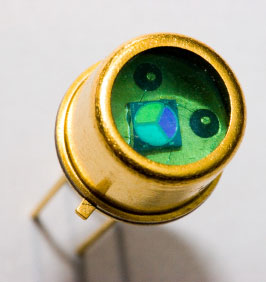Ambient Light Sensors
- Basic Description
-
 Ambient light sensors (ALS) detect the amount of light in the environment and are used by systems that need this information such as headlight controls, interior lighting controls, and climate controls. Light sensors are generally based on one of three types of components: photoresistors, photodiodes or phototransistors. Ambient light sensors (ALS) detect the amount of light in the environment and are used by systems that need this information such as headlight controls, interior lighting controls, and climate controls. Light sensors are generally based on one of three types of components: photoresistors, photodiodes or phototransistors.
- Photoresistors or Photocells are two terminal components, and (as the name implies) the resistance between these terminals varies depending on the amount of light striking the component face. The resistance is proportional to changes in light intensity. However, they are relatively inaccurate and have a property called light "memory" which makes its response to a given light level dependent on previous ambient light levels. Photoresistors require external calibration in all but the simplest applications due to the variation in sensitivity between units. Photoresistors are generally the least expensive light detecting option and have a relatively slow (milliseconds) response time.
- Photodiodes are also two terminal components. They are capable of developing a voltage across the terminals that is proportional to the amount of light striking the sensor surface. Photodiodes exhibit a linear relationship between their output current and the illumination level, but the output current is very small (in the range of tens of nA per 1m/ft2 ) [4]. Also, the photodiode's variation in sensitivity can be up to ±25% between units [4].
- Phototransistors are two terminal transistors. The third terminal, the base in a bipolar transistor or the gate in a field-effect transistor, is replaced by the light collecting surface. The amount of light striking the surface supplies the base (or gate) current and regulates the amount of current that can flow from the collector to emitter (or source to drain). Phototransistors produce an output current proportional to the incident light intensity. They are generally much faster than photoresistors and do not have the light "memory" property. However, the variation in sensitivity can be ±50% or more between units [4]. Phototransistors are slightly more expensive than the other options, but they are more versatile and have quick (nanoseconds) response times.
It is generally desirable for ambient light sensors to imitate the sensitivity of human eyes over the visual spectral range (380 nm to 780 nm with a peak response wavelength of about 550nm) [5]. Unfortunately, most sensor's spectral response is not the same as the human eye because unlike the human eye, ambient light sensors generally respond to infrared (IR) and ultraviolet (UV) light as well. Therefore, displays and light brightness controlled by ambient light sensors may not be optimal for human eyes if IR light is not properly compensated. This issue can be addressed by self compensating circuits or by using an IR filter within the unit.
Ambient light sensor products are gaining popularity as effective solutions for power management and increasing display quality in electronic products and systems. The battery life for portable electronics such as a cell phone or power savings in headlights can be increased significantly by automatic brightness control through ambient light sensor feedback.
- Manufacturers
- AMS, Avago Technologies, Casco, Intersil, Maxim, Melexis, Microsemi, On Semiconductor, Osram, Panasonic, Renesas, Rohm, Sharp, Taos, Vishay, X-Fab
- For More Information
- [1]
Photoresistor, Wikipedia.
- [2] Photodiode, Wikipedia.
- [3] ROHM Ambient Light Sensor Product Training Module, Digikey website.
- [4] VISHAY Ambient Light Sensor Product Training Module And Sensor Selection Criteria, Digikey website.
- [5] Ambient Light Sensing, Single versus Double Diode Measurements, Vishay website.
|

